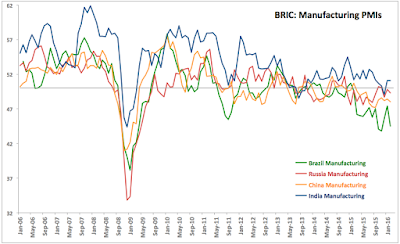Over 2012-2013, sovereign and corporate bonds markets started showing sigs of QE-related fatigue within the system, most commonly associated with periodically volatile trading spreads, term premia and risk spreads. In 2013, following the onset of the Fed-related “taper tantrum” many emerging markets spreads on their sovereign bonds widen dramatically, especially in response to rapid devaluations of their domestic currencies.
“This prompted market analysts to identify five of the worst hit economies as the “fragile five,” attributing their vulnerability to economic fundamentals, particularly to current account deficits.” Which is fine - current account is a reasonably important signal of the overall external balance in the economy, but… the but bit is that current account alone means little. Take for example Russia: back in 2013, the economy enjoyed record current account surpluses - so was a picture of rude health by the analysts criteria. Yet, within the economy there was already an apparent and fully recognised on-going structural slowdown.
Bickering over indicators validity aside, however, it would be nice to know which indicators and which risk models do investors flow when they decide to buy or sell emerging market bonds?
Traditionally, we think about two types of factors: “push” and “pull” factors, determining whether the emerging economy experiences capital inflows or outflows.
- “The push factors often relate to economic or financial developments in the global economy as a whole or in the advanced economies, notably the United States.”
- “The pull factors often relate to country-specific economic fundamentals in emerging markets”
Both push and pull factors seem to be important.
In analyzing returns on sovereign CDS contracts, the BIS paper looks at CDS returns “for 18 emerging markets and 10 advanced countries over 11 years of monthly data from January 2004 to December 2014.”
Findings in a nutshell:
- “Statistical tests for breaks in the movements of CDS returns suggest a break at the time of the eruption of the global subprime crisis in October 2008. This leads us to consider two subperiods separately, an “old normal” before the outbreak of the crisis and a “new normal” afterwards.”
- “In both the old normal and new normal, we seek to explain the variation of these [principal factors] loadings [onto risk premia] in terms of such fundamentals as debt-to-GDP ratios, fiscal balances, current account balances, sovereign credit ratings, trade openness, GDP growth and depth of the domestic bond market.”
- “In the old normal, the first risk factor alone explains about half of the variation in CDS returns…”
- “This factor becomes more dominant in the new normal, in which it explains over three-fifths of the variation in returns.”
- “When it comes to how the different countries load on this factor, we find that that the commonly cited economic fundamentals have little influence on the country-specific loadings on the factor. Instead the single most important explanatory variable for the differences in loadings is a dummy variable that identifies whether or not a country is an emerging market.”
To summarise the BIS findings: “In the end, we find that CDS returns in the new normal move over time largely to reflect the movements of a single global risk factor, with the variation across sovereigns for the most part reflecting the designation of “emerging market”. There seems to be no “fragile five”; there are only emerging markets. While the emerging markets designation may serve to summarize many relevant features of sovereign borrowers, it is a designation that lacks the kind of granularity that we would have expected for a fundamental on which investors’ risk assessments are based. The importance of the emerging markets designation in the new normal suggests that index tracking behaviour by investors has become a powerful force in global bond markets.”
And the cherry on top of the proverbial pie? Why, here it goes: “Haldane (2014) has argued that in the world of international finance, the global subprime crisis and the regulations that followed made asset managers more important than banks. Miyajima and Shim (2014) show that even actively managed emerging market bond funds follow their benchmarks portfolios quite closely. For the most part, when global investors invest in emerging markets, instead of picking and choosing based on country-specific fundamentals, they appear to simply replicate their benchmark portfolios, the constituents of which hardly change over time.”
Wait, what? All regulators are running around the world chasing the bad bankers (for their pre-2008 shenanigans), all the while the new threat has already migrated to asset management. The regulators and enforcers are busy bee-buzzing around courts and regulatory hearings chasing the elusive ‘signalling value’ of enforcing old rules onto the heads of the bankers. With little real outcome to show, I must add. … But the future culprits are not to be found amongst those who care to watch the fate of bankers unfolding in front of them.
In short, having exposed the farce of bond / CDS markets pricing risks based on a vague and vacuous designation of a country, the BIS paper inadvertently also exposed the massive futility of the financial regulators chasing their own tails trying to get past crises culprits to prevent new crises from happening, even though the future culprits don;t give a toss about the past culprits.
Dogs, tails, everything wagging everyone, and vice versa…
Full paper here: Amstad, Marlene and Remolona, Eli M. and Shek, Jimmy, “How Do Global Investors Differentiate between Sovereign Risks? The New Normal versus the Old” (January 2016). BIS Working Paper No. 541: http://ssrn.com/abstract=2722580












